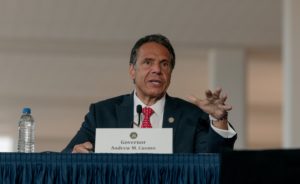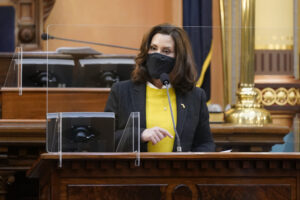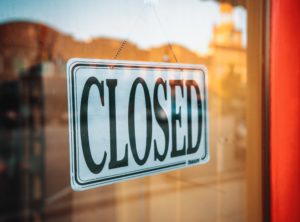State legislatures should be reining in executive emergency powers

Co-authored by Nick Murray from Maine Policy Institute.
This month marks the one-year anniversary of when states and the federal government first declared states of emergency over the spread of COVID-19. Much has changed since then in how we understand the virus, as well as the effects of lockdowns, stay-at-home orders, school closures, and “non-essential” business designations ordered by governors in March 2020. The past year has also changed how we look at the laws that enable our governors to seize and hold such broad powers during an emergency.
We should have seen this coming. A delegate to the nation’s first constitutional convention (and its fourth president), James Madison, wrote in Federalist #47:
“The accumulation of all powers, legislative, executive, and judiciary, in the same hands, whether of one, a few, or many, and whether hereditary, self-appointed, or elective, may justly be pronounced the very definition of tyranny.”
State legislatures have wide-ranging “police powers” to create laws that promote public health, welfare, and safety. While governors and executive officials should have the ability to respond quickly to an imminent crisis, the ultimate responsibility for determining public policy rests with state legislatures. It is their constitutional duty to provide a check on their governors, even in emergency situations.
Unfortunately, many state legislators abdicated this duty and took a backseat to their governor’s often-broad-reaching, often-onerous mandates.
This year, Maine Policy Institute published the first scorecard of every state’s emergency law, grading each on whether the process guarantees the legislature—the people’s body—a seat at the table in determining an emergency exists. The analysis found that far too many states do not strike an adequate balance between the legislative and executive branches, enabling runaway executive authority under declared states of emergency.
The states that scored the worst on Maine Policy’s scorecard granted the governor sole authority to determine when and where an emergency exists, and thus whether to grant himself or herself broad powers outlined in statute.
The best states required a balanced process for declaring and extending emergencies that involve the consent of the legislature. For instance, Kansas scored the highest, because their law gives the governor 15 days to respond to an emergency before requiring concurrence from the full legislature. Now, the legislature can grant only one 30-day emergency declaration after those initial 15 days, but the State Finance Council may allow for an additional 30-day extension with a unanimous vote.
Pacific Legal Foundation developed model bill language this year to help state legislators craft bills to restore the balance of power in their state government, even during times of crisis.
It is likely that state legislators never intended these laws to be used for emergencies that persist for an entire year. Many states’ emergency powers laws were created during the Cold War, and most had not been revised since the SARS epidemic in 2002. Now is the time to take a serious look at state emergency management laws.
Of course, it is important for governors to have authority to act quickly when a disaster, attack, or other threat is imminent. What is equally important are the safeguards to ensure that representative government does not become a casualty of the crisis as well.
No matter who occupies the governor’s office, state lawmakers should ensure that they are in appropriate counterbalance to the executive branch. This should include requiring majority legislative support to extend a state of emergency.
Additionally, a law requiring any emergency order to sunset, or automatically lapse, if not ratified by the legislature would ensure that the governor consults with legislators before issuing potentially damaging edicts.
States could also allow the legislature to nullify specific emergency orders and prohibit the governor from issuing previously nullified orders. Lawmakers should be able to strike down an egregious order without taking the state of emergency with it.
Other substantial, liberty-strengthening reforms include requiring that emergency orders be issued only by the governor, that those orders are “narrowly tailored,” and that challenges to emergency orders receive expedited judicial review. This would signal to courts to weigh any orders against the liberty of the aggrieved party, not simply chalk it up as a “political question” to punt back to the legislature.
The effort to rein in executive emergency powers is a classic interbranch dispute and is not, or at least should not be, a partisan issue. Democrat and Republican legislators have sponsored bills that place temporal limitations on executive emergency powers. Democrat and Republican lawmakers have voted for reform when the current governor is in their own party or the other party. More shocking than legislators stepping up to retake their constitutional mantles are legislators who, for partisan or political reasons, decline to fulfill their duty to make law.
Almost every state has had bills introduced that curb executive emergency power. Many of those bills relate only to the current pandemic; they focus on public health emergencies or address certain actions taken by governors (i.e., business closures). But the most forward-looking reforms place safeguards on all emergency powers, regardless of the underlying emergency.
Kentucky was the first in the nation to pass comprehensive emergency powers reform legislation to limit emergency orders to 30 days without legislative approval and prohibit the governor from reissuing a substantially similar order. Governor Andrew Beshear vetoed the bill, but the legislature overrode the veto. Utah passed a similar bill that is awaiting the governor’s signature. Bills that limit governor emergency power have been introduced in almost every state. At least 11 additional states have bills pending with these vital components.
The common thread among the most effective emergency powers reform efforts is that each proscribes a process that carries on no matter the politics of the moment. Instead of simply acknowledging that the legislature may step in with a majority vote to terminate an emergency, these bills require the chief executive, after an initial grace period, to present his or her findings to legislators, build consensus, and forge a path to deal with an emergency backed by the people’s representatives.
In response to his legislature’s pursuit of reform, Utah Governor Spencer Cox noted, “Emergency powers belong to the legislative branch. They grant them.” The people make the laws—we couldn’t have said it better.












